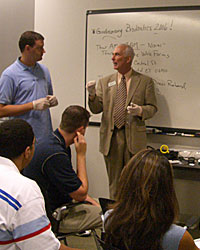
|

|
Background of Biodontics®
Universities fulfill their missions when they develop new paradigms, explore new directions, infuse their students with fresh knowledge and ideas, and provide them with the tools needed to advance positive change. To turn our University's behaviors and cultures toward those, which value, embrace, and advance sustainability, we are developing the Biodontics® Initiative. Through this initiative, the School of Dental Medicine will bring to all its operations, academic offerings, services, and research a principled environmental ethic and a resolve to create a sustainable future. Moreover, the University will produce a new generation of Oral Health professionals who will inherently embody and advance such values and ethics in their own lives, and in those of coming generations.
In consultation with the National Advisory Dental and Craniofacial Research Council (NADCRC), the National Institute of Dental and Craniofacial Research (NIDCR) in 1999 established the Blue Ribbon Panel on Research Training and Career Development to Meet the Scientific Opportunities of the 21st Century. The purpose of the meeting was to identify anticipated opportunities in health-related research in the coming years and the skills that will be needed to take advantage of those opportunities. ”. It was the view of the Panel that health-related research at the start of the 21st Century will be quite unlike that which we observe today.
- There will continue to be a rise in interdisciplinary studies in the coming years, requiring scientists to acquire a broader mix of skills and the ability to work collaboratively.
- There will be an expanded phase of functional genomic analyses following an extended period of rapid advances in genetics and genome-based research – especially the Human Genome Project and microbial genomes.
- There will be an even greater emphasis on applied research, which includes domestic and international collaborative translational and clinical research, population-based studies, epidemiology, health promotion, and health services research.
With these proposed directions, the Blue Ribbon Panel also felt that there would be an increase in the application of research findings to health promotion and disease prevention -- locally, nationally, and globally. Scientists will at a minimum need to be familiar with the knowledge and methods of a wider variety of “disciplines” than is presently the case, in addition to having general skills necessary for tomorrow’s scientific environment. Some examples of emerging critical competencies include: molecular biology, bioengineering, biomathematics, information science, physiology, biochemistry, endocrinology, epidemiology, behavioral and social sciences; quantitative analytic skills; team/collaborative skills; ethics and bioethics training; oral and written communication skills; management skills, entrepreneurship and knowledge of technology transfer approaches.
The Blue Ribbon Panel on Research Training and Career Development made several conclusions in response to the charges. Specifically, the Panel members:
…Identified three major areas of scientific opportunity in the 21st century, including interdisciplinary research and training.
…Recommended that core competencies be fostered across all research training programs, including management skills, entrepreneurship and knowledge of technology transfer approaches.
…Recommended Expand the Mix of Disciplines in Dental, Craneofacial, and Oral Health Research
…Recommended Adopt New Strategies to Promote Diversity in the Scientific Workforce
Dental education has arrived into a new era. During the last 150 years, it has evolved from a short prelude to apprenticeship into a comprehensive program for dental education. Advances in science and technology has converted our profession and dentists into respected professionals, and dental schools are part of the nation’s leading public and private universities. The future of dental education will be shaped by a great number of scientific, technological, political and economic factors that are to be addressed by our profession. Schools of Dentistry have important choices to make. They may attempt to abide by the status quo, or they can decide to follow a more challenging and innovative path of reassessing and renewing its mission of education, clinical practice and research.
To successfully enter the new era and age of dentistry, dental educators, and institutions should perceive and attempt formulating new proposals, alternatives, and paths. Dental education must be undertaken in an environment in which the creation and acquisition of new scientific and clinical knowledge are valued and actively pursued. With this premise, dental leaders should pursue and cooperate in the reform of practices. Contributions should not only be made in education and clinical practice, but also in the areas of research, technology, biotechnology, administration and technology transfer.
|
